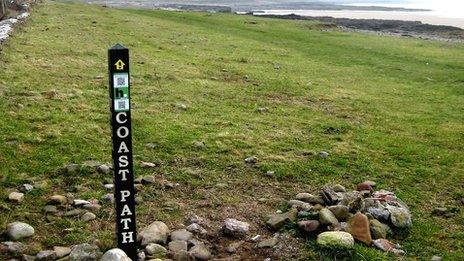QR code on coastal path marks Mumbles lifeboat disaster
- Published
A maritime disaster off the south Wales coast 66 years ago is being marked with an electronic information post.
Walkers can read the story of the Mumbles lifeboat crew who died in 1947 during an ill-fated rescue mission by scanning a QR code with their phone.
RNLI volunteers hope the post at Sker Point, near Porthcawl, will encourage people to learn about what happened and visit a memorial nearby.
It is the latest addition to a 230-barcode trail on the Wales Coast Path.
The History Points organisation, which helps groups and societies inform the public about local history, worked with Bridgend council and the RNLI to install the newest post.
On the evening of 23 April 1947, Mumbles lifeboat - the Edward Prince of Wales - was launched following a distress call from an American steamer called the Samtampa.
The steamer had hit rocks in gales and stormy seas on its way to Newport Docks with 39 men on board.
After failing to find the boat, the lifeboat returned to base to wait for news.

The QR code can be seen on a memorial post at Sker Point
The eight-strong crew was told conditions were too dangerous to attempt another rescue but with the lives of 39 sailors at stake, they ignored the warnings and relaunched.
Tragically, as the weather lifted the following morning, the wreckages of both the Samtampa and the capsized lifeboat were discovered off the coast at Ogmore.
All 47 men had perished.
History Points editor Rhodri Clark said: "People seem to love a real-life story of heroism and tragedy and certainly one in living memory of our grandparents, if not our parents."
The information can be downloaded onto mobile phones, tablets or similar devices with a suitable QR code reader installed.
'Pause for reflection'
RNLI volunteer Ian Stroud, based in Porthcawl, said the information point would increase the prominence of a nearby memorial point.

Mumbles lifeboat disaster QR code
"A memorial to the lifeboat crew and sailors who drowned is located on the rocks below the Welsh Coastal Path. However, many people walk by without realising that the memorial is there," he said.
"At low water on big tides, wreckage from the Samtampa can still be seen in the rocks in a south, south-westerly direction from the memorial.
"The ruggedness of the coastline here, especially when storms are blowing, makes you realise the bravery of the Mumbles lifeboat crew who attempted to rescue the sailors on board the stricken Samtampa on that fateful night."
The memorial site is maintained by both the Porthcawl RNLI and Porthcawl coastguard.
Mr Stroud added: "Hopefully modern technology will allow more people to read the story on their mobile screens, and perhaps pause for reflection, while they look over the spot where the upturned lifeboat was found."
History Points was established in Conwy in January last year to provide a platform for societies, public bodies and educational institutions to inform the general public about local history or the past achievements of group members.
There are more than 500 QR points across Wales, which the organisation says are cheaper than traditional plaques and memorials.